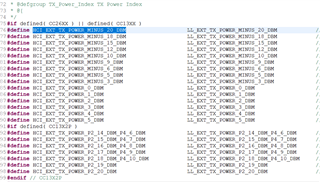Other Parts Discussed in Thread: ENERGYTRACE
Hi, I use CC2652P, simplelink_cc13x2_26x2_sdk_4_40_04_04, CCS10.2.
My application is based on dmm example as below

In my application, I need to tx BLE extended Adv data using AUX_ADV_IND PDU, and now extended adv data works well.
I can use CC1352P-2 LaunchPad as a sniffer in Smart RF Studio and I can see aux adv data in Smart RF Studio.
And I can also use HCI_LE_SetHostChanClassificationCmd to set channels on aux_adv_ind PDUs.
Then , I want to change tx power on AUX_ADV_IND PDU, and to see RSSI on Smart RF Studio.
I use HCI_EXT_SetTxPowerCmd() with these values

My device is very colse to LaunchPad.
But whatever tx power I set, RSSI on Smart RF Stuidio is always about -30dBm.
Only I take my device away from LauchPad can RSSI drop to -40, -50, -60 dBm.
So I want to ask, maybe using HCI_EXT_SetTxPowerCmd to set aux_adv_ind PDU is incorrect?
How to make it right?
Thanks.

